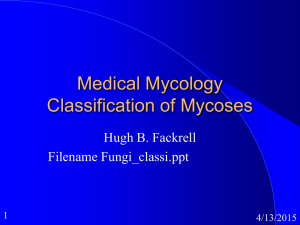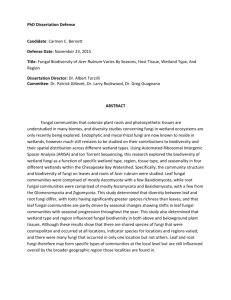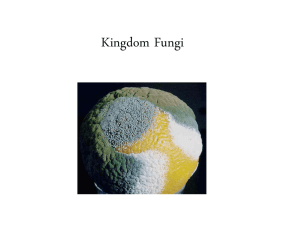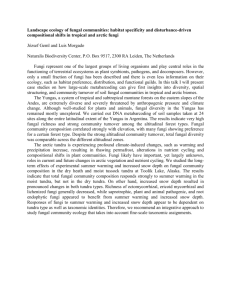An Introduction to Medical Mycology
advertisement
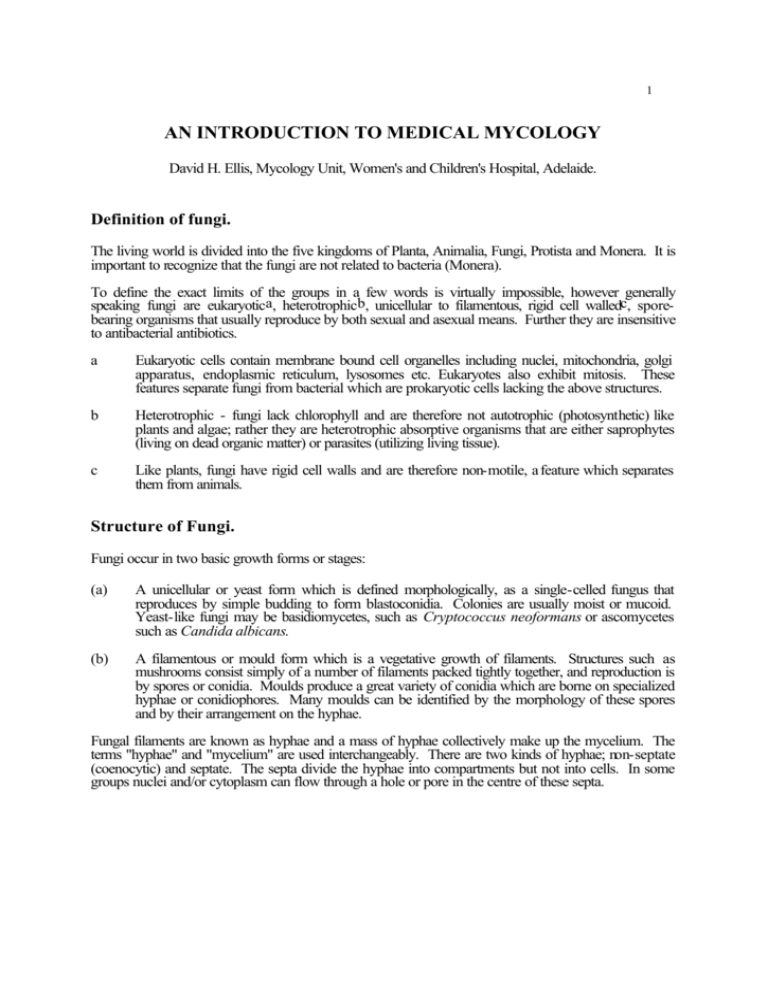
1 AN INTRODUCTION TO MEDICAL MYCOLOGY David H. Ellis, Mycology Unit, Women's and Children's Hospital, Adelaide. Definition of fungi. The living world is divided into the five kingdoms of Planta, Animalia, Fungi, Protista and Monera. It is important to recognize that the fungi are not related to bacteria (Monera). To define the exact limits of the groups in a few words is virtually impossible, however generally speaking fungi are eukaryotica, heterotrophicb, unicellular to filamentous, rigid cell walledc, sporebearing organisms that usually reproduce by both sexual and asexual means. Further they are insensitive to antibacterial antibiotics. a Eukaryotic cells contain membrane bound cell organelles including nuclei, mitochondria, golgi apparatus, endoplasmic reticulum, lysosomes etc. Eukaryotes also exhibit mitosis. These features separate fungi from bacterial which are prokaryotic cells lacking the above structures. b Heterotrophic - fungi lack chlorophyll and are therefore not autotrophic (photosynthetic) like plants and algae; rather they are heterotrophic absorptive organisms that are either saprophytes (living on dead organic matter) or parasites (utilizing living tissue). c Like plants, fungi have rigid cell walls and are therefore non-motile, a feature which separates them from animals. Structure of Fungi. Fungi occur in two basic growth forms or stages: (a) A unicellular or yeast form which is defined morphologically, as a single-celled fungus that reproduces by simple budding to form blastoconidia. Colonies are usually moist or mucoid. Yeast-like fungi may be basidiomycetes, such as Cryptococcus neoformans or ascomycetes such as Candida albicans. (b) A filamentous or mould form which is a vegetative growth of filaments. Structures such as mushrooms consist simply of a number of filaments packed tightly together, and reproduction is by spores or conidia. Moulds produce a great variety of conidia which are borne on specialized hyphae or conidiophores. Many moulds can be identified by the morphology of these spores and by their arrangement on the hyphae. Fungal filaments are known as hyphae and a mass of hyphae collectively make up the mycelium. The terms "hyphae" and "mycelium" are used interchangeably. There are two kinds of hyphae; non-septate (coenocytic) and septate. The septa divide the hyphae into compartments but not into cells. In some groups nuclei and/or cytoplasm can flow through a hole or pore in the centre of these septa. 2 Fungi with non-septate hyphae typically belong to the Zygomycetes. Non-septate hyphae are considered to be more primitive because if a hyphal strand is damaged the entire strand dies. Septate hyphae are typically found in the Basidiomycetes and Ascomycetes, the latter also includes the hyphomycetes or conidial fungi. When a septate hyphal strand is damaged, the pores between adjacent compartments can be plugged, thus preventing death of the whole hyphal strand. Two basic types of reproductive propagules are found in the fungi: (a) Sexual propagules are produced by the fusion of two nuclei that then generally undergo meiosis. Sexual methods of reproduction involve plasmogamy (cytoplasmic fusion of two cells), karyogamy (fusion of two nuclei), genetic recombination and meiosis. The resulting haploid spore is said to be a sexual spore, e.g. zygospores, ascospores and basidiospores. If a sexual spore is produced only by fusion of a nucleus of one mating type with a nucleus of another mating type (+ and - strains), the fungus is said to be heterothallic. In contrast, homothallic moulds produce sexual spores following the fusion of two nuclei from the same strain. (b) Asexual propagules are termed either spores or conidia depending on their mode of production, and which arise following mitosis of a parent nucleus. Conidia arise either by budding off conidiogenous hyphae or by differentiation of preformed hyphae. Asexual spores are commonly formed by consecutive cleavages of a sporangium. Asexual forms of reproduction represent the major method for the maintenance and dissemination of many fungi. Classification of Fungi. Separation of taxa is still primarily based on the method of spore production of the perfect or sexual state (teleomorph) and three major subdivisions, the Zygomycota, Ascomycotina and Basidiomycotina are generally recognized. However for convenience mycologists often recognize an additional artificial subdivision called the Deuteromycotina to accommodate of those fungi without a perfect state, but which may represent the asexual states (anamorphs) of either Basidiomycotina or Ascomycotina. ZYGOMYCETES (bread or pin moulds). Fast growing, terrestrial, largely saprobic fungi with non motile cells; cosmopolitan (665 species). Hyphae coenocytic and mostly aseptate. Asexual spores include chlamydoconidia, conidia and sporangiospores contained in sporangia borne on simple or branched sporangiophores. Sexual reproduction is isogamous producing a thick-walled sexual resting spore called a zygospore. However, most isolates are heterothallic i.e. zygospores are absent, therefore identification is based primarily on sporangial morphology. Medically important orders and genera include: 1. Entomophthorales subcutaneous zygomycosis (Entomophthoromycosis) - Conidiobolus and Basidiobolus. 2. Mucorales - subcutaneous and systemic zygomycosis (Mucormycosis) - Rhizopus, Mucor, Rhizomucor, Absidia, Cunninghamella, Mortierella, Saksenaea and Apophysomyces. 3 BASIDIOMYCETES (mushrooms and toadstools) Saprobes and parasites (esp. of plants), terrestrial; cosmopolitan (16,000 species). Hyphae septate with complex septal pores called dolipores which allow cytoplasmic but not nuclear migration. Hyphae are dikaryotic and can often be distinguished by the presence of clamp connections over the septa. Sexual reproduction is by the formation of exogenous basidiospores, typically four, on a basidium. Occasional species produce conidia but most are sterile. Four classes may be distinguished: Hymenomycetes (mushrooms), Gasteromycetes (puff balls), Urediniomycetes (rusts) and Ustilaginomycetes (smuts). Genera of medical importance include: 1. 2. 3. Teleomorphs of known pathogenic fungi, e.g. Filobasidiella. Coprinus and Schizophyllium agents of basidiomycosis. Mushroom poisoning by Aminita, Lepiota, Coprinus and Psilocybe etc. ASCOMYCETES (common moulds) Saprobes, parasites (esp. of plants), or lichen forming, mostly terrestrial; cosmopolitan (28,650 species). Hyphae septate with simple septal pores, cytoplasmic and nuclear migration not inhibited. Asexual reproduction is by conidia. Sexual reproduction is by the formation of endogenous ascospores, typically eight, in an ascus. Asci are often housed in a fruiting body or ascocarp e.g. cleistothecia or perithecia. No classes are now recognized; although in the past they have often been grouped on how the asci were arranged (Hemiascomycetes, Plectomycetes, Pyrenomycetes, Discomycetes, Laboulbeniomycetes and Loculoascomycetes). Medically important genera include the teleomorphs of known pathogenic fungi e.g. Arthroderma, Nannizzia, Ajellomyces, Pseudallescheria, Eurotium etc., agents of mycetoma, like Leptosphaeria and Neotestudina, and of black piedra, like Piedraia hortae. HYPHOMYCETES (conidial moulds) A class of mycelial moulds which reproduce asexually by conidia on hyphae or aggregations of hyphae but not within discrete conidiomata. No sexual state is present; cosmopolitan (l7,000 species). Hyphae are septate, having simple ascomycetous septal pores. This class contains the majority of medically important fungi. Dematiaceous Hyphomycetes are those conidial fungi that produce dark brown, green-black, or black colonies and are the causative agents of phaeohyphomycosis. Hyaline Hyphomycetes include those conidial fungi which are not darkly pigmented, colonies may be colourless or brightly coloured. These include the agents of hyalohyphomycosis, aspergillosis, dermatophytosis and the dimorphic pathogens, like Histoplasma capsulatum. Identification of the hyphomycetes is primarily based on microscopic morphology of the conidia, their arrangement, and on what type of cell produces them. Culture characteristics, although less reliable may also be useful. These include surface texture, topography and pigmentation, reverse pigmentation and growth at 37oC. 4 FUNGAL PATHOGENICITY The ability of fungi to cause disease appears to be an accidental phenomenon. With the exception of a few dermatophytes, pathogenicity among the fungi is not necessary for the maintenance or dissemination of the species. The two major physiologic barriers to fungal growth within the human body are temperature and redox potential. Most fungi are mesophilic and can not grow at 37oC. Similarly, most fungi are saprophytic and their enzymatic pathways function more efficiently at the redox potential of non-living substrates than at the relatively more reduced state of living metabolizing tissue. In addition, the body has a highly efficient set of cellular defences to combat fungal proliferation. Thus, the basic mechanism of fungal pathogenicity is its ability to adapt to the tissue environment and to withstand the lytic activity of the host's cellular defences. In general, the development of human mycoses is related primarily to the immunological status of the host and environmental exposure, rather than to the infecting organism. A small number of fungi have the ability to cause infections in normal healthy humans by (1) having a unique enzymatic capacity, (2) exhibiting thermal dimorphism and (3) by having an ability to block the cell-mediated immune defences of the host. There are then many "opportunistic" fungi which cause infections almost exclusively in debilitated patients whose normal defence mechanisms are impaired. The organisms involved are cosmopolitan fungi which have a very low inherent virulence. Currently, there has been a dramatic increase in fungal infections of this type, in particular candidiasis, cryptococcosis, aspergillosis, and zygomycosis. More recently described mycoses of this category include hyalohyphomycosis and phaeohyphomycosis. Altogether, some 200 "human pathogens" have been recognized from among an estimated 1.5 million species of fungi. CLINICAL GROUPINGS FOR FUNGAL INFECTIONS SKIN MYCOLOGY Superficial Mycoses Cutaneous Mycoses Subcutaneous Mycoses INFECTIOUS DISEASE MYCOLOGY Dimorphic Systemic Mycoses Opportunistic Systemic Mycoses SKIN MYCOLOGY The Superficial Mycoses These are superficial cosmetic fungal infections of the skin or hair shaft. No living tissue is invaded and there is no cellular response from the host. Essentially no pathological changes are elicited. These infections are often so innocuous that patients are often unaware of their condition. 5 Pityriasis (tinea) versicolor A chronic, superficial fungal disease of the skin characterized by well-demarcated white, pink, fawn, or brownish lesions, often coalescing, and covered with thin furfuraceous scales. The colour varies according to the normal pigmentation of the patient, exposure of the area to sunlight, and the severity of the disease. Lesions occur on the trunk, shoulders and arms, rarely on the neck and face, and fluoresce a pale greenish colour under Wood's ultra-violet light. Young adults are affected most often, but the disease may occur in childhood and old age. Distribution: World-wide but more common in tropical than temperate climates. Aetiological Agent: Malassezia furfur a lipophilic yeast forming part of the normal flora of human skin. The Cutaneous Mycoses These are superficial fungal infections of the skin, hair or nails. No living tissue is invaded, however a variety of pathological changes occur in the host because of the presence of the infectious agent and its metabolic products. Dermatophytosis - Ringworm or Tinea Ringworm of scalp, glabrous skin, and nails caused by a closely related group of fungi known as dermatophytes which have the ability to utilize keratin as a nutrient source, i.e. they have a unique enzymatic capacity - keratinase. The disease process in dermatophytosis is unique for two reasons: (a) No living tissue is invaded the keratinized stratum corneum is simply colonized. However, the presence of the fungus and its metabolic products usually induces an allergic and inflammatory eczematous response in the host. The type and severity of the host response is often related to the species and strain of dermatophyte causing the infection. (b) The dermatophytes are the only fungi that have evolved a dependency on human or animal infection for the survival and dissemination of their species. The Dermatophytes can be divided into 3 broad epidemiological groups. GEOPHILIC These dermatophytes normally inhabit the soil where they are believed to decompose keratinaceous debris. Some species may cause infections in animals and man following contact with soil (e.g. Microsporum gypseum). ZOOPHILIC These dermatophytes are primarily parasitic on animals. Infections may be transmitted to man following contact with animal host (e.g. Microsporum canis). ANTHROPOPHILIC These dermatophytes are primarily parasitic on man and have only rarely been known to infect animals, presumably following contact with man (e.g. Trichophyton rubrum). 6 NOTE: Anthropophilic fungi such as Microsporum audouinii, Trichophyton rubrum, Trichophyton schoenleinii, Trichophyton tonsurans and Trichophyton violaceum are unable to colonize animals other than man. They are the only fungi that have developed a dependency on man for the maintenance and dissemination of their species. Ecology of Human Dermatophyte Species in Australia Anthropophilic Species: Incidence Trichophyton rubrum Trichophyton tonsurans Trichophyton rubrum granular type T. mentagrophytes var. interdigitale Epidermophyton floccosum Trichophyton violaceum T. mentagrophytes var. nodulare Trichophyton concentricum Microsporum ferrugineum Trichophyton schoenleinii Trichophyton soudanense Microsporum audouinii Very Common Common Common Common Common Less Common Rare Rare* N/A N/A N/A N/A * PNG and Pacific Islands Common Zoophilic Species Incidence Microsporum canis T. mentagrophytes var. mentagrophytes Trichophyton equinum Trichophyton verrucosum T. mentagrophytes var. quinckeanum Microsporum canis var. distortum Microsporum equinum T. mentagrophytes var. erinacei Common Common Rare Rare Rare* Rare Rare N/A (NZ only) * Common during mice plagues Geophilic Species Incidence Microsporum gypseum Microsporum fulvum Microsporum nanum Microsporum cookei Trichophyton terrestre Trichophyton ajelloi Common Rare Rare Rare Rare Rare The Subcutaneous Mycoses These are chronic, localized infections of the skin and subcutaneous tissue following the traumatic implantation of the aetiologic agent. The causative fungi are all soil saprophytes of regional epidemiology whose ability to adapt to the tissue environment and elicit disease is extremely variable. 7 Sporotrichosis Primarily a chronic mycotic infection of the cutaneous or subcutaneous tissues and adjacent lymphatics characterized by nodular lesions which may suppurate and ulcerate. Infections are caused by the traumatic implantation of the fungus into the skin, or very rarely, by inhalation into the lungs. Secondary spread to articular surfaces, bone and muscle is not infrequent, and the infection may also occasionally involve the central nervous system, lungs or genitourinary tract. Distribution: World-wide particularly tropical and temperate regions. Aetiological Agent: Sporothrix schenckii, commonly found in soil and on decaying vegetation. Chromoblastomycosis A mycotic infection of the cutaneous and subcutaneous tissues characterized by the development in tissue of dematiaceous (brown-pigmented), planate-dividing, rounded sclerotic bodies. Infections are caused by the traumatic implantation of fungal elements into the skin and are chronic, slowly progressive and localized. Tissue proliferation usually occurs around the area of inoculation producing crusted, verrucose, wart-like lesions. Distribution: World-wide but more common in bare footed populations living in tropical regions . Aetiological Agents: Various dematiaceous hyphomycetes associated with decaying vegetation or soil, especially Phialophora verrucosa, Fonsecaea pedrosoi, F. compacta and Cladosporium carrionii. Mycetoma A mycotic infection of humans and animals caused by a number of different fungi and actinomycetes characterized by draining sinuses, granules and tumefaction. The disease results from the traumatic implantation of the aetiologic agent and usually involves the cutaneous and subcutaneous tissue, fascia and bone of the foot or hand. Sinuses discharge serosanguinous fluid containing the granules which vary in size, colour and degree of hardness, depending on the aetiologic species, and are the hallmark of mycetoma. Distribution: World-wide but most common in bare-footed populations living in tropical or subtropical regions. Aetiological Agents: Actinomycotic mycetoma: Nocardia, Actinomadura and Streptomyces. Eumycotic mycetoma: Madurella, Acremonium, Pseudallescheria, Exophiala, Leptosphaeria, Curvularia, Fusarium, Aspergillus etc. 8 INFECTIOUS DISEASE MYCOLOGY Dimorphic Systemic Mycoses These are fungal infections of the body caused by dimorphic fungal pathogens which can overcome the physiological and cellular defences of the normal human host by changing their morphological form. They are geographically restricted and the primary site of infection is usually pulmonary, following the inhalation of conidia. Histoplasmosis An intracellular mycotic infection of the reticuloendothelial system caused by the inhalation of the fungus. Approximately 95% of cases of histoplasmosis are inapparent, subclinical or benign. Five percent of the cases have chronic progressive lung disease, chronic cutaneous or systemic disease or an acute fulminating fatal systemic disease. All stages of this disease may mimic tuberculosis. Distribution: World-wide, especially U.S.A. Sporadic cases do occur in Australia. Aetiological Agent: Histoplasma capsulatum, especially from soil enriched with excreta from chicken, starlings and bats. Coccidioidomycosis Initially, a respiratory infection, resulting from the inhalation of conidia, that typically resolves rapidly leaving the patient with a strong specific immunity to re-infection. However, in some individuals the disease may progress to a chronic pulmonary condition or as a systemic disease involving the meninges, bones, joints and subcutaneous and cutaneous tissues. Distribution: Aetiological Agent: Endemic in south-western U.S.A., northern Mexico and various centers in South America. Coccidioides immitis, a soil inhabiting fungus. Opportunistic Systemic Mycoses Opportunistic fungal infections of the body occur almost exclusively in debilitated patients whose normal defence mechanisms are impaired. The organisms involved are cosmopolitan fungi which have a very low inherent virulence. The increased incidence of these infections and the diversity of fungi causing them, has paralleled the emergence of AIDS and the use of antibiotics, cytotoxins, immunosuppressives, steroids and other macro disruptive procedures that result in lowered resistance of the host. Mycoses in the Neutropenic Patient. In the neutropenic patient virtually any fungus that can grow at 37oC and gain access to the bloodstream may cause disseminated infection. These infections pose enormous problems in terms of initial clinical recognition, diagnosis and laboratory identification of the causative agent. The prevalence of serious fungal infections in these patients is constantly increasing, especially candidiasis. 9 Percentages of fatal infections in cancer patients caused by opportunistic fungi. Leukemia Lymphoma Solid tumour 30 15 5 * endemic areas Candidiasis Aspergillosis Zygomycosis Cryptococcosis Histoplasmosis Coccidioidomycosis Hyalohyphomycosis 44-80 20-30 Rare Rare Rare* Rare* Rare Mycoses in the AIDS Patient. The emergence of AIDS has been responsible for a dramatic increase in human infections caused by the yeast-like fungi Candida and Cryptococcus. Mucosal candidiasis occurs in almost all AIDS patients with C. albicans accounting for greater than 85% of infections. Cryptococcal infection in patients with AIDS is considered incurable, and lifelong therapy is necessary to suppress the infection. Almost all infections are caused by C. neoformans var. neoformans. In fact, AIDS is the classic setting for this fungus which has the ability to inhibit phagocytosis and survive the non-specific inflammatory immune defences of the host. Fungal infections in AIDS patients Oral candidiasis Oesophageal candidiasis Cryptococcosis 40-90% 50% 3-33% Histoplasmosis Coccidioidomycosis Pulmonary aspergillosis Cerebral Sporotrichosis Hyalohyphomycosis Phaeohyphomycosis Dermatophytosis 5-30%* Rare* 5% Rare Rare Rare 20-90% * endemic areas Diagnosis of Systemic Mycoses The successful diagnosis and treatment of fungal infections in the immunocompromised patient is very much dependant on a team-work approach which inevitably involves communication between a large number of individuals ranging from Infectious Disease Physicians, Microbiologists, Oncologists, Histopathologists and various scientific and technical laboratory staff. 10 Diagnosis of systemic opportunistic fungal infections. CLINICAL RECOGNITION CASE HISTORY PHYSICAL EXAMINATION ORGAN IMAGING DIRECT MICROSCOPY HISTOPATHOLOGY LABORATORY SPECIMEN Skin and nail scrapings, urine, sputum, bronchial washings, CSF, pleural fluid, peritoneal fluid, tissue biopsies and indwelling catheter tips. CULTURE AND IDENTIFICATION SERODIAGNOSTIC TESTS Laboratory Specimen Processing In general, direct microscopy and culture should be performed on all specimens received by the laboratory. Microscopy provides vital information, often an immediate presumptive diagnosis is possible, which is of particular importance in the immunosuppressed patient. Microscopy usually consists of either (a) wet mounts in 10% KOH with Parker ink, or india ink, (b) smears for Gram, Giemsa and PAS staining, and (c) histopathology of tissue sections using H&E, Gomori methenamine silver (GMS) and PAS. Note: Candida and Aspergillus may be missed in H&E stained sections, therefore GMS stained sections are essential for tissue pathology. Routinely, cultures should be maintained for one month. Cultures should be examined regularly, fungal growths identified and significant isolates reported as soon as possible. Clinicians also need to be aware of the following laboratory requirements in order to generate an appropriate specimen for a diagnosis. 1. A relevant clinical history. This information is vital to the laboratory; (a) it enhances processing of the specimen which in some cases may increase the likely isolation of some fungi, especially zygomycetes; (b) it aids in the determination of significance of fungal isolates, especially those from non-sterile sites such as sputum, bronchial washings and skin; and (c) it is the only way of alerting laboratories that they may be dealing with a potential pathogen. The safety of laboratory staff will depend on this information as cultures of dimorphic fungi like Histoplasma capsulatum represent a severe biohazard and must be handled with extreme caution in an appropriate pathogen handling cabinet. 2. An adequate amount of suitable clinical material. Unfortunately many specimens submitted are either of an inadequate amount or are not appropriate to make a definite diagnosis. The laboratory needs enough specimen to perform both microscopy and culture. Too often specimens are either placed totally in formalin, thus allowing no culture or alternatively they are not sent to histopathology. 11 3. At present, serological tests, with the possible exception of antigen detection for Cryptococcus neoformans, are of limited value and must be supported by clinical, cultural and other evidence. 4. With the exception of histopathology, routine laboratory turn around time for the isolation and identification of fungi and sensitivity testing may take several weeks. Even for Candida albicans, this may take up to 5 days, 8 days for other yeasts and common moulds like Aspergillus, and often 2 to 4 weeks for other filamentous moulds. Although histopathology offers the most rapid confirmatory diagnosis it is not always possible to obtain suitable biopsy material or to make a specific identification of the fungus. Basically, the clinician will need to make a clinical diagnosis and commence antifungal treatment well in advance of any laboratory confirmation. Candidiasis A primary or secondary mycotic infection caused by members of the genus Candida. The clinical manifestations may be acute, subacute or chronic to episodic. Involvement may be localized to the mouth, throat, skin, scalp, vagina, fingers, nails, bronchi, lungs, or the gastrointestinal tract, or become systemic as in septicaemia, endocarditis and meningitis. In healthy individuals, Candida infections are usually due to impaired epithelial barrier functions and occur in all age groups, but are most common in the newborn and the elderly. They usually remain superficial and respond readily to treatment. Systemic candidiasis is usually seen in patients with cell-mediated immune deficiency, and those receiving aggressive cancer, immunosuppression, or transplantation therapy. Several species of Candida may be aetiological agents, most commonly, Candida albicans and rarely C. tropicalis, C. krusei. C. parapsilosis, C. guilliermondii, C. kefyr (C. pseudotropicalis) and C. (Torulopsis) glabrata. All are ubiquitous and occur naturally on humans. Percentages of Candida sp. isolates from the oral cavity, gastrointestinal tract and vagina. C. albicans C. glabrata C. tropicalis C. parapsilosis C. krusei C. kefyr C. guilliermondii Oral 70 7 7 2 2 1 >1 Gastro 51 10 2 5 3 >1 >1 Vaginal 69 12 6 >1 3 >1 >1 Clinical material: Skin and nail scrapings; urine, sputum and bronchial washings; cerebrospinal fluid, pleural fluid and blood; tissue biopsies from various visceral organs and indwelling catheter tips. 12 Predisposing Factors for the Development of Candidiasis Impaired Epithelial Barrier Burns Hydration/maceration Indwelling catheters Increased gastric pH Irradiation Wounds/abrasions Occlusion Foreign bodies (dentures, etc) Cytotoxic agents Antibiotics Constitutional Disorders Diabetes mellitus Hypothyroidism Polyendocrinopathy Malnutrition Iron deficiency Biotin deficiency Hypoadrenalism Hypoparathyroidism Pregnancy/oral contraceptives Malabsorption Zinc deficiency Hypovitaminosis A Neutrophil and Macrophage Disorders Neutropenia Leukopenia Agranulocytosis Acrodermatitis enteropathica Myeloperoxidase deficiency Chronic granulomatous disease Immune Disorders (Primary and Acquired) Thymic alymphoplasia Thymic hypoplasia Hyper-IgE syndrome Severe combined immunodeficiency Chronic mucocutaneous candidiasis Acquired immunodeficiency syndrome Malignancy and Haematologic Disorders Leukemia Thymoma Lymphoma Advanced cancer Drugs and Therapeutic Agents Antibiotics Colchicine Cytotoxic agents Irradiation Corticosteroids Phenylbutazone Antimetabolites Immunosuppressive agents (taken from Ray, T.L. Cutaneous and disseminated skin manifestations of candidiasis, Chapter 4, in Cutaneous Fungal Infections edited by Boni Elewsli, Igaku-Shoin New York and tokyo, 1992). 13 Cryptococcosis A chronic, subacute to acute pulmonary, systemic or meningitic disease, initiated by the inhalation of basidiospores and/or desiccated yeast cells of C. neoformans. Primary pulmonary infections have no diagnostic symptoms and are usually subclinical. On dissemination, the fungus usually shows a predilection for the central nervous system, however skin, bones and other visceral organs may also become involved. Although C. neoformans is regarded as the principle pathogenic species, C. albidus and C. laurentii have on occasion also been implicated in human infection. Clinical material: Cerebrospinal fluid (csf), sputum, pus, blood and biopsy tissue. C. neoformans is an encapsulated basidiomycetous yeast-like fungus which has been divided into two varieties; C. neoformans var. neoformans and C. neoformans var. gattii. C. neoformans var. neoformans (A and D serotypes) has a world-wide distribution and is now one of the most significant world-wide opportunistic pathogens in humans, especially in AIDS patients. It has been isolated from various sources in nature and is noted for its association with accumulations of avian guano, especially with pigeon excreta. The fungus has also been isolated from the dung of caged birds including canaries, parrots and budgerigars. Other environmental isolations of C. neoformans var. neoformans have been from rotting vegetables, fruits and fruit juices, wood, dairy products and soil. C. neoformans var. gattii (serotypes B and C) has a more restricted global distribution corresponding to a subtropical to tropical climate. Environmental isolations have now established that C. neoformans var. gattii has a specific ecological association with Eucalyptus camaldulensis (the river red gum) and E. tereticornis (the forest red gum). Zygomycosis (Mucormycosis) Zygomycosis in the debilitated patient is the most acute and fulminate fungal infection known. The disease typically involves the rhino-facial-cranial area, lungs, gastrointestinal tract, skin, or less commonly other organ systems. It is often associated with acidosis diabetes, malnourished children, severely burned patients and other diseases such as leukemia and lymphoma, immunosuppressive therapy, or use of cytotoxins and corticosteroids. The infecting fungi have a predilection for invading vessels of the arterial system, causing embolization and subsequent necrosis of surrounding tissue. The aetiological agents are cosmopolitan members of the Mucorales, including Rhizopus arrhizus/oryzae, Rhizopus microsporus, Rhizomucor pusillus, Absidia corymbifera, Cunninghamella bertholletiae, Mucor species, Saksenaea vasiformis, Apophysomyces elegans and Mortierella wolfii. Clinical material: Skin scrapings from cutaneous lesions; sputum and needle biopsies from pulmonary lesions; nasal discharges, scrapings and aspirates from sinuses in patients with rhinocerebral lesions; and biopsy tissue from patients with disseminated disease. 14 Aspergillosis Aspergillosis is a spectrum of diseases of humans and animals caused by members of the genus Aspergillus. These include (1) mycotoxicosis due to ingestion of contaminated foods; (2) allergy and sequelae to the presence of conidia or transient growth of the organism in body orifices; (3) colonization without extension in preformed cavities and debilitated tissues; (4) invasive, inflammatory, granulomatous, necrotizing disease of lungs, and other organs; and rarely (5) systemic and fatal disseminated disease. The type of disease and severity depends upon the physiologic state of the host and the species of Aspergillus involved. The aetiological agents are cosmopolitan and include Aspergillus fumigatus, A. flavus, A. niger, A. nidulans and A. terreus. Clinical material: Skin and nail scrapings; urine, sputum and bronchial washings; cerebrospinal fluid, pleural fluid and blood; tissue biopsies from various visceral organs and indwelling catheter tips. Hyalohyphomycosis A mycotic infection of man or animals caused by a number of hyaline (non-demtiaceous) hyphomycetes where the tissue morphology of the causative organism is mycelial. This separates it from phaeohyphomycosis where the causative agents are brown-pigmented fungi. Hyalohyphomycosis is general term used to group together infections caused by unusual hyaline fungal pathogens that are not agents of otherwise-named infections. Aetiological agents include species of Penicillium, Paecilomyces, Acremonium, Beauveria, Fusarium, Trichoderma and Scopulariopsis. Clinical material: Skin and nail scrapings; urine, sputum and bronchial washings; cerebrospinal fluid, pleural fluid and blood; tissue biopsies from various visceral organs and indwelling catheter tips. Phaeohyphomycosis A mycotic infection of humans and lower animals caused by a number of dematiaceous (brownpigmented) fungi where the tissue morphology of the causative organism is mycelial. This separates it from other clinical types of disease involving brown-pigmented fungi where the tissue morphology of the organism is a grain (mycotic mycetoma) or sclerotic body (chromoblastomycosis). Clinical forms of the disease range from localized superficial infections of the stratum corneum (tinea nigra) to subcutaneous cysts (phaeomycotic cyst) to invasion of the brain. The aetiological agents include various dematiaceous hyphomycetes especially species of Exophiala, Phialophora, Wangiella, Bipolaris, Exserohilum, Xylohypha, Phaeoannellomyces, Aureobasidium, Cladosporium, Curvularia, Phoma and Alternaria. Currently 71 species from 39 genera have been reported as causative agents of phaeohyphomycosis. Clinical material: Skin scrapings; sputum and bronchial washings; cerebrospinal fluid, pleural fluid and blood; tissue biopsies from various visceral organs and indwelling catheter tips. References Rippon, J.W. 1988. Medical Mycology (3rd. edition). W.B. Saunders Co. Kwon-Chung, K.J. and J.E. Bennett. 1992. Medical Mycology. Lea & Febiger.
